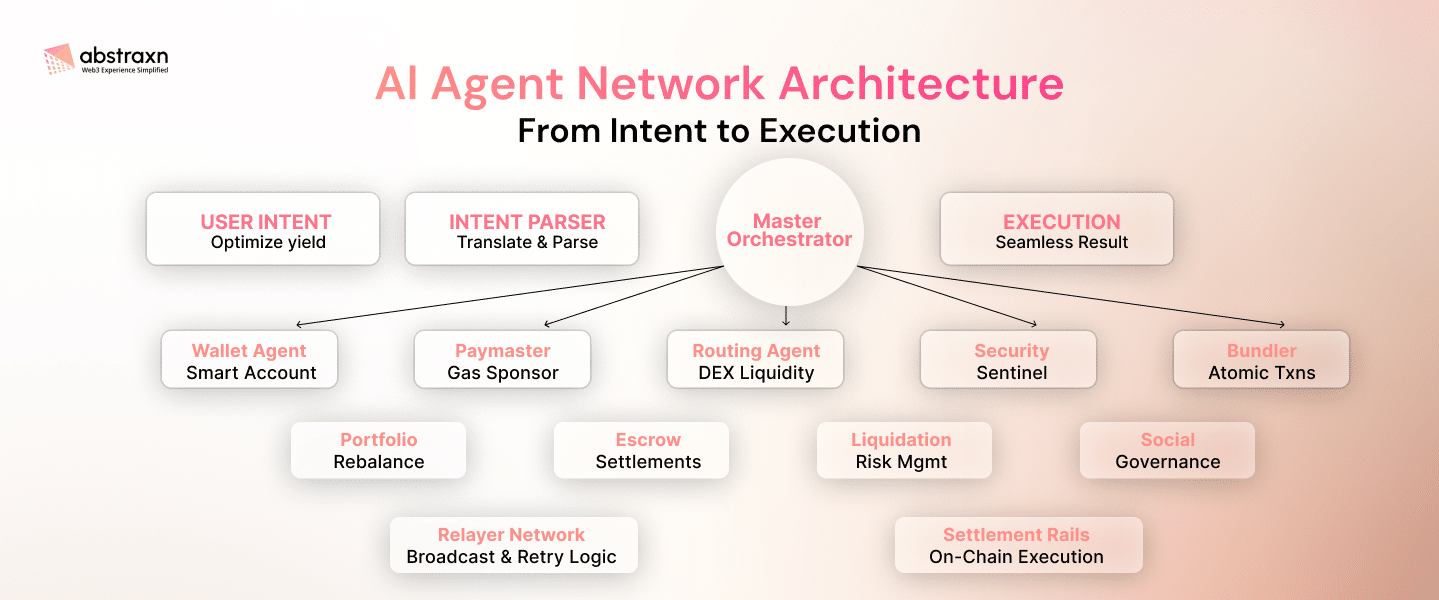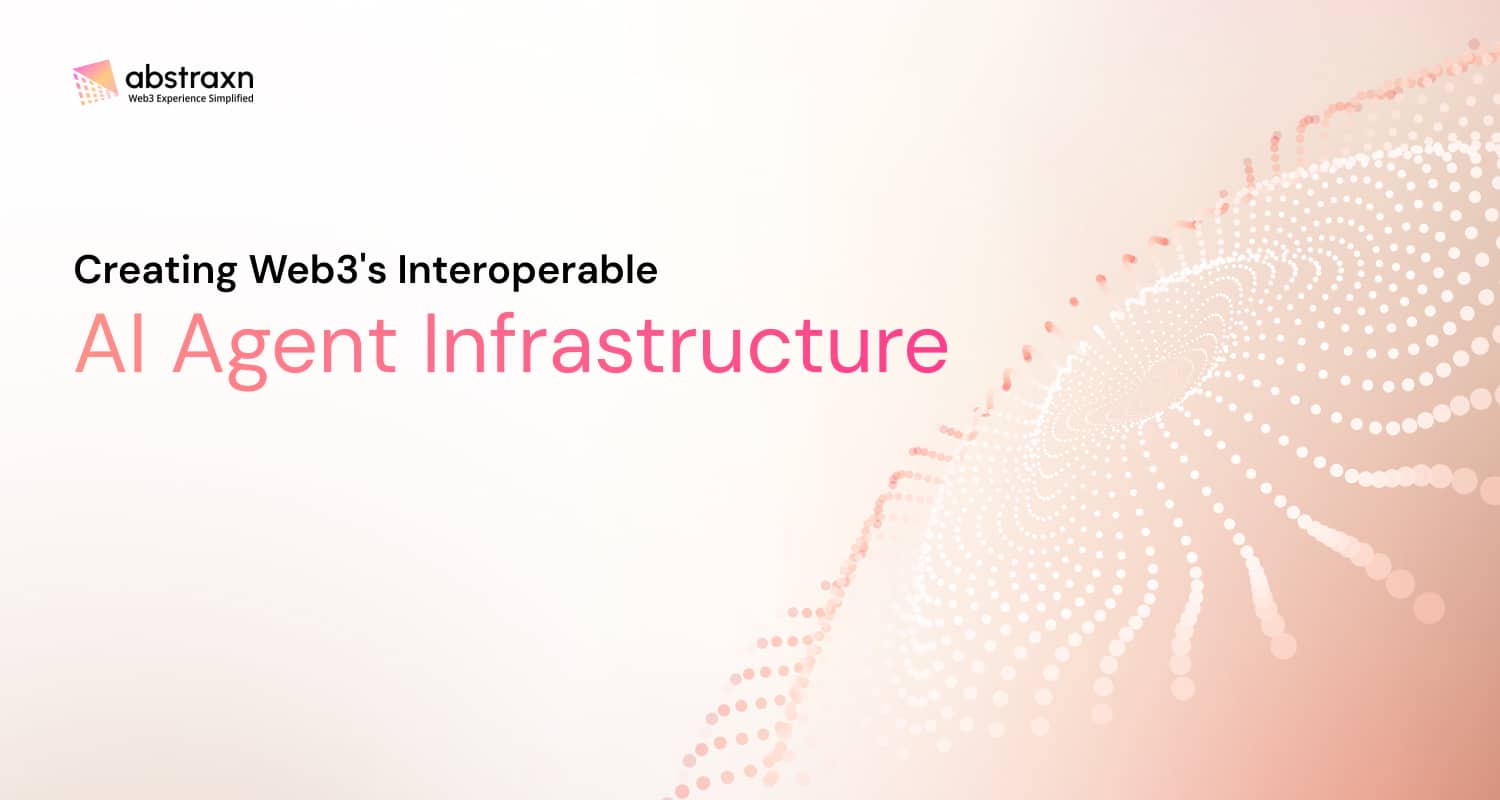Three trends converged in 2024 to accelerate an inevitable shift: protocol standardization, agent interoperability, and autonomous execution. The result? A sprawling digital ecosystem where millions of autonomous agents in blockchain networks collaborate without human intervention.
A user casually requests ‘optimize my cross-chain yield’ and an AI agent network immediately starts assembling specialists: a portfolio agent rebalances allocations, a routing agent sources liquidity across DEXs, a paymaster agent handles fee mechanics, and a smart account in crypto executes an atomic, auditable flow. Each actor is sovereign, credentialed, and discoverable, and plays one specific role that spans off-chain signals and on-chain settlement. This isn’t speculative fiction – it is the emerging reality of protocol-level agentic intelligence infrastructure.
The convergence of Anthropic’s Model Context Protocol open-sourcing in November 2024 and the formalization of agent-to-agent communication standards has fundamentally shifted the Web3 landscape.
Identity, Standards & Protocols in AI Agent Networks
The agentic future rests on three technical pillars: verifiable identity, shared messaging/coordination standards, network discovery & governance.
Sovereign Agent Identity Framework: Every autonomous agent receives a decentralized identifier (DID) or NFT-backed credential on network entry, verifying its cryptographic proof of origin, abilities, and operational boundaries. These aren’t static identities – each agent accumulates reputation scores governed by protocols like LOKA, creating dynamic trust profiles that affect network standing and collaboration opportunities.
This identity layer changes how we conceptualize smart accounts in crypto environments.
Protocol Standards for Agent Communication: For discovery and messaging, emerging standards are crystallizing into key infrastructure. The Model Context Protocol (MCP) allows agents to find compatible peers, share tool capabilities, and invoke cross-platform functions with end-to-end security. Agent-to-Agent (A2A) protocols permit direct negotiation, task delegation, and resource sharing between specialized agents operating across different blockchain networks.
Overarching these communication layers is the Agent Network Protocol (ANP), which enables network-wide discovery, load balancing, and resource allocation.
Abstraxn’s Protocol-Native Architecture: By creating its stack around these nascent protocols, AbstraXn’s AI for blockchain ensures every agent – from paymaster agents managing gas sponsorship to security sentinels validating contract integrity – communicates, authenticates, and operates within an ethical network.
Our AI Agent Network Infrastructure: From Intent to Execution
Abstraxn’s intelligence architecture follows a simple design decision: treat intent as the primary API, and create an interoperable network of specialized agents that reliably execute that intent. The result is an ecosystem that composes smart account wallets, paymaster logic, routing, security checks, and settlement into a single and trackable transaction flow that never asks the user to manage the plumbing.

Core Components:
- Master Orchestrator (central hub): picks up high-level user requests, checks the registry of capabilities, and delegates task parcels to specialist agents. It monitors progress, enforces policy, and assembles the final execution plan.
- Intent Parser: translates natural language or structured product intents into parameterized actions (amounts, routing constraints, slippage limits) that agents can utilise.
- Wallet Agent/ Smart Account: manages account abstraction, session keys, and the final on-chain execution. It implements per-account policies (limits, multisig thresholds) before signing.
- Paymaster Agent: evaluates sponsorship eligibility, applies budget rules, and (when required) sponsors gas or routes cost to the platform’s settlement rails.
- Routing & Bundler Agents: scout DEX liquidity, select cross-chain routes, compose atomic bundles, and reorder steps to minimise slippage and reversion risk.
- Relayer Layer: resilient relayers broadcast bundles, tackle retries, and extend delivery guarantees (receipt, webhooks).
- Security/ Sentinel Agent: performs real-time audits, checks contracts, and transaction preconditions, and can halt or need human confirmation for risky flows.
- Specialized agents: Escrow, Portfolio, Liquidation, Social, etc. – each holds domain logic and ability that the orchestrator can recruit.
This architecture streamlines fragmented processes into a dependable product: intent-based crypto transactions that are verifiable, interoperable, and fault-tolerant. For product and infrastructure teams, it means less time rebuilding gas logic or retrying mempool failures and more time shipping features that users actually complete.
Relayer and bundler architecture operates transparently, with every agent action recorded. Additionally, the governance framework maintains a delicate balance between autonomous operation and accountable execution, fortifying AI in Web3 systems to operate with higher independence while preserving the transparency and verification standards of decentralized networks.
Why Protocol-Level Infrastructure Matters?
Conventional approaches create proprietary ecosystems where autonomous agents in blockchain environments work in isolation, unable to use collective intelligence or share critical security insights across network boundaries. This fragmentation costs in several ways: duplicated security audits across platforms, incompatible smart account wallets that cannot interact with external agent networks, and paymaster agents locked into single-chain operations despite users’ multi-chain asset distribution.
The result is a patchwork of disconnected AI capabilities that fail to deliver the seamless, cross-protocol experiences that modern DeFi demands. But protocol-level foundations turn this collection of one-off integrations into an interoperable fabric, and this shift has concrete business-facing implications.
It delivers:
- Interoperability at scale: Standard messaging and context protocols let third-party agents (routing, escrow, sentinel, paymaster) work together regardless of vendor/ cloud. That makes capabilities composable.
- Lower integration cost: When discovery, identity, and messaging adhere to shared specifications, product teams stop reinventing the same plumbing and cut pilot time dramatically.
- Reduced vendor lock-in: Open standards let you swap or add agents without rewriting the stack.
- Stronger provenance & auditability: Identity frameworks (DIDs, credentialed NFTs) and protocol-level logging establish a single source of truth for the purpose of transaction, which is critical for enterprise compliance.
- Marketplace & economics: Network-level discovery and payment semantics enable agent marketplaces: teams can find, sort, and pay specialized agents instead of building them in-house.
Large platform vendors are already embracing it: Google published A2A specifications for cross-agent messaging, and Microsoft has publicly committed support for A2A and MCP across its AI tooling suite and related platforms.
The strategic implication is clear: protocol-level infrastructure isn’t just technical architecture – it is competitive positioning for the next decade of Web3 evolution.
Real-World Frameworks Shaping Agentic AI Implementation
The academic and protocol work around multi-agent systems isn’t abstract background noise – it’s the instruction manual Abstraxn uses to turn agent concepts into production features. Three frameworks in particular – ISEK’s coordination fabric, Coral Protocol, and LOKA – provide clear patterns for secure messaging, capability publishing, governance, and lifecycle control. Abstraxn maps these patterns directly into platform primitives so that partners get predictable and composable behaviour.
- ISEK’s Coordination Fabric Model: The theoretical foundation for modern AI agent networks relies on established coordination frameworks. ISEK’s six-phase model demonstrates how agents operate in continuous cycles: capability publication, peer discovery, recruitment protocols, task execution, outcome settlement, and feedback exchange. This way, Abstraxn translates single intents into multi-agent workflows that remain accountable.
- Coral Protocol’s Modular Architecture Standards: Its messaging and capability discovery ideas inform Abstraxn’s selection of context formats and tool-access patterns (MCP/A2A compatible). So, any agent can declare a tool (on-chain swap, oracle call), and any requester can call it using standard payloads, thus reducing custom adapters and accelerating integration.
- LOKA’s Governance Framework: Abstraxn’s sentinel and policy layers are modeled by LOKA’s emphasis on identity, reputation, and decentralized governance. This addresses the critical challenge of embedding ethical decision-making into agent lifecycles. Agents carry verifiable credentials (DIDs/NFT claims), reputation scores, and human-in-the-loop checkpoints exist for high-risk actions.
From Theory To Implementation
These frameworks represent battle-tested approaches that shape Abstraxn’s architectural decisions. By mapping each infrastructure layer to proven coordination models, AbstraXn’s AI for blockchain bridges the gap between theoretical agent cooperation and practical intent-based crypto transactions. This systematic approach guarantees that agents deliver emergent collaborative value rather than operating as sophisticated but isolated tools – creating network effects that compound as more agents join the ecosystem.
Future Possibilities in Decentralized AI Agent Networks
The next chapter is no more isolated agents, but coordination at scale. As standards, identity, and discovery mature, the future will be an interoperable, economic, and governed ecosystem of agents – one that converts specialized capabilities into predictable and composable outcomes for product teams.
Swarm Intelligence Evolution
We are nearing a paradigm shift where autonomous agents in blockchain environments will self-organize into dynamic swarms – temporary coalitions that handle complex multi-dimensional challenges simultaneously. Drawing from swarm-AI research in cybersecurity, these formations enable parallel processing of intricate operations like coordinated liquidation protection across multiple positions in a single coordinated action.
Autonomous Economic Networks
The upcoming AI agent networks will give rise to vibrant internal marketplaces where agents discover, negotiate, and compensate each other automatically through tokenized micro-payments. Paymaster agents might auction gas sponsorship services to the highest-efficiency routing agents, and more. This creates self-sustaining economic loops within the network.
Proactive Intelligence Emergence
The ultimate evolution moves autonomous AI transaction flows from reactive execution to predictive action. Advanced agents will analyse user behavior patterns, market conditions, and portfolio performance to identify opportunities before the users. This proactive capability represents true emergence: behaviors and value creation that go beyond individual agent programming, arising from complex interactions within the decentralized AI agent networks.
The Abstraxn Edge: Strategic Impact for Partner Companies
Abstraxn transforms emerging AI in Web3 abilities into product outcomes: faster launches, new monetization sources, and safer automation – without forcing teams to become protocol implementers.
Early Protocol Adoption: For B2B clients, early integration with Abstraxn’s protocol-aligned stack extends immediate and long-term strategic benefits.
- Immediate plug-and-play interoperability: Partners can instantly tap into existing agentic AI ecosystems without building proprietary integrations, accessing established agent networks that process transactions and optimize workflows.
- Forward-compatibility insurance: As new AI agent networks emerge and evolve, partners maintain seamless connectivity without architectural overhauls, preventing development costs while getting automatic access to enhanced capabilities.
This positioning transforms integration risk from a technical liability into a competitive advantage.
Accelerated Development Cycles: Teams gain access to comprehensive infrastructure advantages that remove foundational bottlenecks.
- Fully compliant protocol toolkits: MCP/A2A/ANP implementations cut months off R&D cycles, allowing teams to focus on differentiating features rather than building smart account wallets or custom paymaster agents from scratch.
- Built-in governance frameworks: Sophisticated audit trails, reputation metrics, and human-in-the-loop oversight mechanisms automatically address compliance requirements across various jurisdictions.
- Battle-tested infrastructure: Proven components manage complex protocol interactions seamlessly – transforming regulatory complexity from a development bottleneck into a simplified foundation layer.
From Adopters to Contributors: As decentralized AI agent networks grow and agentic standards solidify across the industry, partner companies will transition from passive technology adopters to active ecosystem contributors. This leads to compounding advantages: partners influence standards that benefit their use cases, get early access to emerging capabilities, and establish thought leadership positions within the AI in Web3 space.
The result is sustainable competitive differentiation that strengthens over time.
Looking Ahead
The architecture and standards described above are a fast-moving foundation, not the final finished product. Over the next months, Abstraxn will roll out the practical tooling that turns promise into practice:
- Governance dashboards for traceable decision-making
- Community-driven agent marketplace for discoverability and vetted capability exchange
- Cross-chain compensation rails, so that third-party agents can be paid reliably at a micro scale.
What follows those launches is where the trajectory of the industry becomes clear: richer AI agent network marketplaces, standardized agent economics, and governance primitives that let humans set policies and machines execute within those bounds.
Stay tuned for our next blog, as we unpack Abstraxn’s governance tooling in detail.




